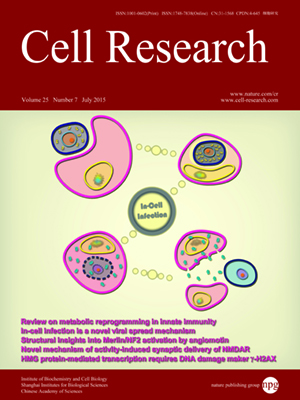
Volume 25, No 7, Jul 2015
ISSN: 1001-0602
EISSN: 1748-7838 2018
impact factor 17.848*
(Clarivate Analytics, 2019)
Volume 25 Issue 7, July 2015: 864-876 | Open Access
ORIGINAL ARTICLES
Integrative genome-wide analysis reveals HLP1, a novel RNA-binding protein, regulates plant flowering by targeting alternative polyadenylation
Yong Zhang1,*, Lianfeng Gu1,*, Yifeng Hou2,*, Lulu Wang1, Xian Deng1, Runlai Hang1, Dong Chen3, Xiansheng Zhang2, Yi Zhang3, Chunyan Liu1 and Xiaofeng Cao1,4
1State Key Laboratory of Plant Genomics and National Center for Plant Gene Research, Institute of Genetics and Developmental Biology, Chinese Academy of Sciences, Beijing 100101, China
2State Key Laboratory of Crop Biology, College of Life Sciences, Shandong Agricultural University, Taian, Shandong 271018, China
3Center for Genome Analysis, ABLife Inc., Novonest Building, 8 Nanhu Avenue, East Lake Hi-Tech Development Zone, Wuhan, Hubei 430064, China
4Collaborative Innovation Center of Genetics and Development, Shanghai 200433, China
Correspondence: Chunyan Liu ; Xiaofeng Cao(cyliu@genetics.ac.cn ; xfcao@genetics.ac.cn)
Alternative polyadenylation (APA) is a widespread mechanism for gene regulation and has been implicated in flowering, but the molecular basis governing the choice of a specific poly(A) site during the vegetative-to-reproductive growth transition remains unclear. Here we characterize HLP1, an hnRNP A/B protein as a novel regulator for pre-mRNA 3′-end processing in Arabidopsis. Genetic analysis reveals that HLP1 suppresses Flowering Locus C (
FLC), a key repressor of flowering in Arabidopsis. Genome-wide mapping of HLP1-RNA interactions indicates that HLP1 binds preferentially to A-rich and U-rich elements around cleavage and polyadenylation sites, implicating its role in 3′-end formation. We show HLP1 is significantly enriched at transcripts involved in RNA metabolism and flowering. Comprehensive profiling of the poly(A) site usage reveals that HLP1 mutations cause thousands of poly(A) site shifts. A distal-to-proximal poly(A) site shift in the flowering regulator
FCA, a direct target of HLP1, leads to upregulation of
FLC and delayed flowering. Our results elucidate that HLP1 is a novel factor involved in 3′-end processing and controls reproductive timing via targeting APA.
10.1038/cr.2015.77
FULL TEXT | PDF
Browse 2262


